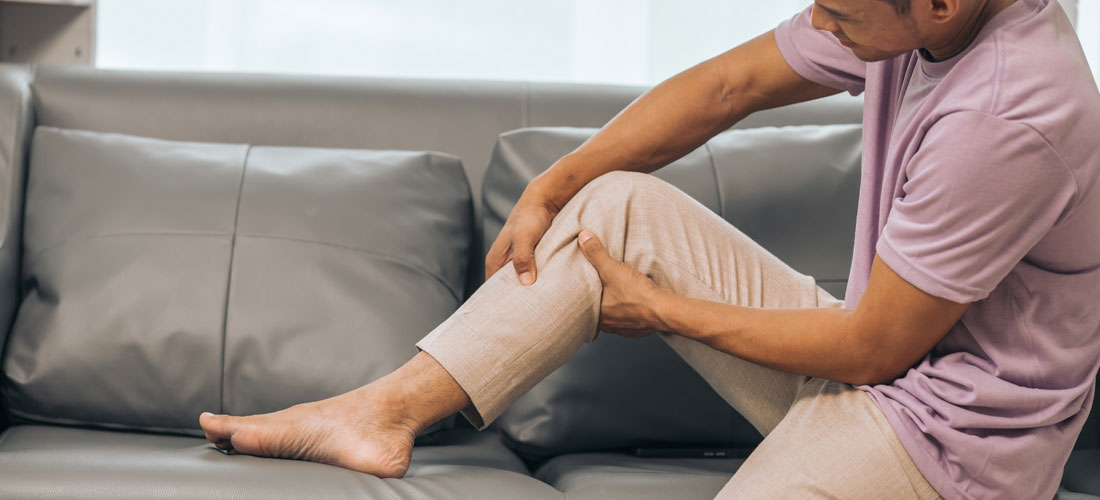Deep Vein Thrombosis (DVT)
Deep Vein Thrombosis (DVT) occurs when a blood clot (thrombus) forms in one or more of the deep veins of the body—most commonly in the legs. This happens when blood flow becomes slow or stagnant, or when the inner lining of the vein is damaged. The clot can partially or completely obstruct circulation within the vein. While DVT most often affects the lower limbs, it can also occur in the arms, pelvis, or, more rarely, in the veins of the abdomen, brain, or kidneys.
Although DVT itself may not immediately threaten life, the clot can break loose and travel through the bloodstream. If it reaches the lungs, it can cause a pulmonary embolism (PE)—a potentially life-threatening emergency. Prompt diagnosis and treatment are therefore essential.
Over time, some individuals develop post-thrombotic syndrome, characterized by persistent leg pain, swelling, and skin changes due to long-term venous damage and increased pressure within the affected veins.
Common consequences of chronic DVT include:
- Pooling of blood and chronic leg swelling
- Increased venous pressure
- Skin pigmentation changes or discoloration
- Non-healing wounds or venous ulcers
DVT and PE together represent the third most common vascular disorder after heart attack and stroke. In the U.S., it is estimated that 1–3 per 1,000 adults develop DVT or PE each year, with significant mortality if untreated. The risk rises with age, prolonged immobility, hospitalization, and certain medical conditions.
Symptoms of Deep Vein Thrombosis
DVT commonly develops in the veins of the legs or arms. In many cases, symptoms are mild or absent, which makes early detection challenging. Typical signs may include:
Swelling in one leg or arm (sometimes sudden)
Pain or tenderness that worsens with standing or walking
Warmth over the affected area
Skin redness or discoloration
Prominent superficial veins
If the clot travels to the lungs, symptoms of pulmonary embolism may appear, such as:
Sudden shortness of breath
Chest pain that worsens with deep breathing or coughing
Rapid heartbeat or breathing
Coughing up blood
Dizziness or fainting
Seek immediate medical attention if these symptoms occur.
Causes
Causes and Risk Factors
- Genetic or inherited clotting disorders
- Cancer or certain cancer treatments (e.g., chemotherapy)
- Previous DVT or family history of blood clots
- Recent surgery, trauma, or immobilization
- Long periods of sitting (e.g., travel or bed rest)
- Pregnancy and postpartum period
- Obesity
- Age over 40
- Use of oral contraceptives or hormone therapy
- Smoking
- Varicose veins
- Chronic inflammatory or autoimmune diseases (e.g., lupus, IBD)
- COVID-19 infection
Diagnosis
Accurate diagnosis is crucial to prevent complications. Common investigations include:
- Duplex Venous Ultrasound: The primary non-invasive test that uses sound waves to visualize blood flow and detect clots.
- CT or MR Venography: Advanced imaging used when ultrasound findings are inconclusive or when pelvic, abdominal, or cerebral veins are involved.
- Venography: A contrast dye study occasionally used when detailed visualization is needed.
- Blood Tests: Specialized tests may be done to evaluate inherited or acquired clotting tendencies.
Treatment
The goals of DVT management are to:
- Prevent clot extension and embolization.
- Reduce the risk of recurrence.
- Minimize long-term complications such as post-thrombotic syndrome.
Medications
The mainstay of treatment is anticoagulation (blood thinners) such as heparin, warfarin, or newer oral anticoagulants. These drugs prevent further clot formation and allow the body to naturally dissolve existing clots over time.
- Duration of therapy typically ranges from 3 to 6 months, but may be longer in patients with recurrent or high-risk conditions.
- Regular follow-up and blood monitoring are essential to ensure effectiveness and safety.
Compression Therapy
Graduated compression stockings help reduce swelling, prevent post-thrombotic symptoms, and improve venous circulation. They should be worn during the day and removed at night.
Lifestyle and Activity
Patients are encouraged to stay active once medically cleared. Elevating the leg, staying hydrated, and avoiding long periods of immobility are important for recovery.
Catheter-Based or Surgical Treatments
In selected cases—such as extensive clots, severe symptoms, or contraindication to anticoagulants—endovascular procedures may be performed. These include:
- Catheter-directed thrombolysis: Using medications to dissolve the clot.
- Mechanical thrombectomy: Removing the clot through minimally invasive devices.
- IVC Filter Placement: Inserting a small device in the inferior vena cava to prevent clots from reaching the lungs, used when anticoagulants cannot be given.
Prevention
For individuals at risk or recovering from DVT:
- Maintain mobility—walk or stretch during long travel or hospital stays.
- Use compression stockings if prescribed.
- Follow postoperative activity and medication instructions carefully.
- Avoid smoking and manage chronic health conditions.
- Stay well hydrated.
Why Choose RIVEA Vascular Institute
RIVEA is India’s leading center dedicated to vascular and endovascular care, offering advanced, image-guided treatments for venous and arterial diseases.
At RIVEA, care is led by Dr. Karthik Mikkineni, a U.S.-trained, American Board of Surgery–certified vascular surgeon with over a decade of experience at institutions such as Stanford University and the Oklahoma City VA.
With a state-of-the-art Hybrid Operating Room powered by GE Healthcare, RIVEA delivers precision-based, minimally invasive DVT care—combining accurate diagnosis, modern treatment, and rapid recovery.
Our Team
-

Dr. Karthik Mikkineni
MD, FACS, FSVS, RPVI
Dr. Karthik Mikkineni is an internationally recognized vascular and endovascular surgeon, known for his pioneering work in complex aortic interventions, limb salvage, and carotid disease management.
View Profile Book an Appointment



